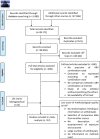Adverse perinatal outcomes associated with prenatal exposure to protease-inhibitor-based versus non-nucleoside reverse transcriptase inhibitor-based antiretroviral combinations in pregnant women with HIV infection: a systematic review and meta-analysis
- PMID: 36717801
- PMCID: PMC9885641
- DOI: 10.1186/s12884-023-05347-5
Adverse perinatal outcomes associated with prenatal exposure to protease-inhibitor-based versus non-nucleoside reverse transcriptase inhibitor-based antiretroviral combinations in pregnant women with HIV infection: a systematic review and meta-analysis
Abstract
Background: About 1.3 million pregnant women lived with HIV and were eligible to receive antiretroviral therapy (ART) worldwide in 2021. The World Health Organization recommends protease inhibitors (PI)-based regimen as second or third-line during pregnancy. With remaining pregnant women exposed to PIs, there is still an interest to assess whether this treatment affects perinatal outcomes. Adverse perinatal outcomes after prenatal exposure to PI-based ART remain conflicting: some studies report an increased risk of preterm birth (PTB) and low-birth-weight (LBW), while others do not find these results. We assessed adverse perinatal outcomes associated with prenatal exposure to PI-based compared with non-nucleoside reverse transcriptase (NNRTI)-based ART.
Methods: We performed a systematic review searching PubMed, Reprotox, Clinical Trial Registry (clinicaltrials.gov) and abstracts of HIV conferences between 01/01/2002 and 29/10/2021. We used Oxford and Newcastle-Ottawa scales to assess the methodological quality. Studied perinatal outcomes were spontaneous abortion, stillbirth, congenital abnormalities, PTB (< 37 weeks of gestation), very preterm birth (VPTB, < 32 weeks of gestation), LBW (< 2500 grs), very low-birth-weight (VLBW, < 1500 g), small for gestational age (SGA) and very small for gestational age (VSGA). The association between prenatal exposure to PI-based compared to NNRTI-based ART was measured for each adverse perinatal outcome using random-effect meta-analysis to estimate pooled relative risks (RR) and their corresponding 95% confidence intervals (CI). Pre-specified analyses were stratified according to country income and study quality assessment, and summarized when homogeneous.
Results: Out of the 49,171 citations identified, our systematic review included 32 published studies, assessing 45,427 pregnant women. There was no significant association between prenatal exposure to PIs compared to NNRTIs for VPTB, LBW, SGA, stillbirth, and congenital abnormalities. However, it was inconclusive for PTB, and PI-based ART is significantly associated with an increased risk of VSGA (sRR 1.41 [1.08-1.84]; I2 = 0%) compared to NNRTIs.
Conclusions: We did not report any significant association between prenatal exposure to PIs vs NNRTIs-based regimens for most of the adverse perinatal outcomes, except for VSGA significantly increased (+ 41%). The evaluation of antiretroviral exposure on pregnancy outcomes remains crucial to fully assess the benefice-risk balance, when prescribing ART in women of reproductive potential with HIV.
Prospero number: CRD42022306896.
Keywords: Antiretroviral therapy; HIV; Perinatal outcomes; Pregnancy; Protease inhibitor; Systematic review.
© 2023. The Author(s).
Conflict of interest statement
The authors have no conflicts of interest to declare.
Figures









Similar articles
-
Adverse perinatal outcomes associated with different classes of antiretroviral drugs in pregnant women with HIV.AIDS. 2025 Feb 1;39(2):162-174. doi: 10.1097/QAD.0000000000004032. Epub 2024 Oct 15. AIDS. 2025. PMID: 39407417 Free PMC article.
-
Adverse perinatal outcomes associated with protease inhibitor-based antiretroviral therapy in pregnant women living with HIV: A systematic review and meta-analysis.EClinicalMedicine. 2022 Apr 6;46:101368. doi: 10.1016/j.eclinm.2022.101368. eCollection 2022 Apr. EClinicalMedicine. 2022. PMID: 35521067 Free PMC article.
-
Comparative risk of adverse perinatal outcomes associated with classes of antiretroviral therapy in pregnant women living with HIV: systematic review and meta-analysis.Front Med (Lausanne). 2024 Feb 27;11:1323813. doi: 10.3389/fmed.2024.1323813. eCollection 2024. Front Med (Lausanne). 2024. PMID: 38476445 Free PMC article.
-
Perinatal outcomes among pregnant women with HIV initiating antiretroviral therapy preconception and antenatally.AIDS. 2025 Apr 1;39(5):584-596. doi: 10.1097/QAD.0000000000004104. Epub 2025 Jan 9. AIDS. 2025. PMID: 39760703 Free PMC article.
-
Perinatal outcomes associated with combination antiretroviral therapy compared with monotherapy.AIDS. 2023 Mar 1;37(3):489-501. doi: 10.1097/QAD.0000000000003432. Epub 2022 Nov 11. AIDS. 2023. PMID: 36695359
Cited by
-
Antiretroviral Therapy in Pregnancy: A 2023 Review of the Literature.Curr HIV/AIDS Rep. 2024 Feb;21(1):1-10. doi: 10.1007/s11904-024-00688-y. Epub 2024 Jan 26. Curr HIV/AIDS Rep. 2024. PMID: 38277098 Free PMC article. Review.
-
Care of the Child Perinatally Exposed to Human Immunodeficiency Virus.Clin Perinatol. 2024 Dec;51(4):881-894. doi: 10.1016/j.clp.2024.08.011. Clin Perinatol. 2024. PMID: 39487026 Review.
-
Evaluation of long-acting cabotegravir safety and pharmacokinetics in pregnant women in eastern and southern Africa: a secondary analysis of HPTN 084.J Int AIDS Soc. 2025 Jan;28(1):e26401. doi: 10.1002/jia2.26401. J Int AIDS Soc. 2025. PMID: 39748218 Free PMC article. Clinical Trial.
-
Antiretroviral drug exposure in pregnancy and risk of congenital anomalies: a European case/non-case malformed study.Eur J Clin Pharmacol. 2025 May;81(5):697-709. doi: 10.1007/s00228-025-03814-w. Epub 2025 Feb 26. Eur J Clin Pharmacol. 2025. PMID: 40011239 Free PMC article.
-
Adverse perinatal outcomes associated with different classes of antiretroviral drugs in pregnant women with HIV.AIDS. 2025 Feb 1;39(2):162-174. doi: 10.1097/QAD.0000000000004032. Epub 2024 Oct 15. AIDS. 2025. PMID: 39407417 Free PMC article.
References
-
- UNAIDS. Global HIV & AIDS statistics — Fact sheet 2022 n.d. https://www.unaids.org/en/resources/fact-sheet (accessed August 2, 2022).
-
- WHO | Consolidated guidelines on the use of antiretroviral drugs for treating and preventing HIV infection: what’s new. WHO n.d. http://www.who.int/hiv/pub/arv/policy-brief-arv-2015/en/ (accessed January 16, 2019).
-
- WHO. Guideline on when to start antiretroviral therapy and on pre-exposure prophylaxis for HIV guidelines 2015. http://apps.who.int/iris/bitstream/10665/186275/1/9789241509565_eng.pdf?... (accessed June 10, 2018). - PubMed
-
- WHO. HIV/AIDS - Key facts 2020. https://www.who.int/news-room/fact-sheets/detail/hiv-aids (accessed January 9, 2019).
Publication types
MeSH terms
Substances
Grants and funding
LinkOut - more resources
Full Text Sources
Medical
Research Materials
Miscellaneous

